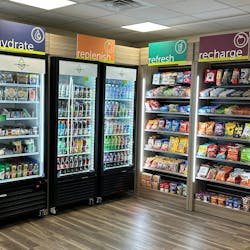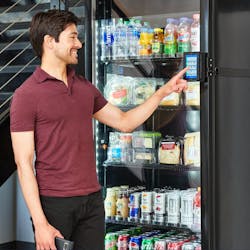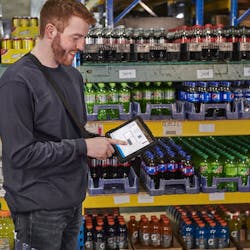The application of roadmap strategies such as digital media, cloud computing, remote management, location based services, mobile payments and more are changing retail as we know it, including vending. Last month, I reviewed several advancements currently under development by technology suppliers and vending operators. This month, I will focus on cloud computing, remote monitoring and mobile payments.
While nearly all industries have tapped the capabilities of cloud computing, the vending industry has been cautiously reluctant, or unaware, of its potential. The term “cloud computing” is used to describe Internet-based computing and therefore the phrase “in the cloud” refers to applications performed via the internet.
A major consideration in cloud computing is that since the Internet supports the bulk of the application, the vending operator does not have to procure dedicated hardware (basic input/output device needed) or specialty software at the operational level. It is for this reason that cloud computing is often described as “software-as-a-service (SaaS)”.
Cloud computing emerges
Accessing a service from the cloud, which may be billed on a subscription basis, is often achieved by opening a browser and completing a secure login procedure. This simplicity is both welcomed and the basis of a concern surrounding security. Fortunately for the vending operator, secured connectivity and authentication are the responsibility of the SaaS provider.
Cloud computing enables the establishment of a communication pathway between a connected vending machine and the vending operator for timely remote messaging (machine alerts. alarms, and calibrated events) aimed at minimizing down time while containing costs (maintenance, replenishment, pre-kitting, and servicing). Cloud computing enables vending operators to have access to important applications (e.g. vending management software and cyber wallets) through an Internet web browser.
In the past few years, some vending companies switched from company-owned hardware and software assets to a cloud-based subscription service model. This form of automation offers the opportunity to deploy technology without a large upfront capital expenditure or an abundance of on-premises hardware or software.
In essence, cloud computing enables on-demand access to a shared set of automated resources (networks, servers, storage, and applications) with minimal service provider interaction. There are SaaS vending management software (VMS) packages and remote machine monitoring (RMM) applications available, as well as recently introduced applications involving virtual wallets, dynamic couponing, and enterprise resource planning (ERP) solutions.
The objectives of cloud computing are: improved productivity, minimized risk of downtime, maintenance of current application, highly secured access, data protection, and reductions in capital expenditures. Several branches of the V-Engineering roadmap include mobile devices having seamless access to cloud-based applications.
Cloud enables remote monitoring
Remote machine monitoring (RMM) applications were the first managed through the cloud and continue to be among the most popular. RMM applications can be accomplished through a variety of wireless network technologies. RMM equipped vending machines are configured to transmit data over the network to a connected cloud-based server.
Vending machines are polled on a regular basis and sales audit and alarm data are transmitted to a remote solution provider network for analysis and data storage. The remote application software typically analyzes the data to determine the inventory status of product sales, by column, of each machine.
An additional forecasting algorithm may be applied to predict additional sales likely to occur by the time of the next date of service. This data can then be used to provide a dynamic replenishment (pre-kitting) and service schedule (dynamic scheduling). Once a dynamic schedule is derived, its contents can be used to construct pre-pick lists for each machine and can then be aggregated to produce location, route, and truckload reports. Cloud-based RMM capabilities are significantly enhanced through the incorporation of accurate and timely data, producing:
Dynamic Forecasting: Having data indicating when coins or currency require collection or knowing machine inventory levels for pre-pick replenishment or awareness of maintenance or service alarms in advance of route trafficking can be of assistance in determining warehousing needs as well as tracking product movement. Pre-packing (pre- kitting) products at the warehouse can significantly impact route efficiencies.
Dynamic Notification: Machine communication of events and alarm conditions can be used to monitor and manage machines. Key factors related to machine functionality, inventory movement, mechanics, and settlement data.
Dynamic Pricing: Two-way communication between a machine and remote device can enable remote price updating from a distant location.
Dynamic Scheduling: Since not all machines will require service, collection, or replenishment on a fixed schedule basis, a dynamic scheduling algorithm is capable of constructing a flexible routing without reliance on inefficient, static routing.
Dynamic Routing: Given the flexibility of dynamic scheduling, route maps can be built based on required stops (e.g. servicing or replenishment). Dynamic routing software can be applied to produce an efficient routing scheme.
Dynamic Couponing: Digital coupons can be found on Websites, through Web advertisements, received via email, pushed by opt-in programs, or available through related digital media. The difference between a traditional printed coupon and a dynamic coupon is its unique ‘call-to-action’ (apply in a timely manner). The fact that the coupon is usually time and/or location specific (i.e. expires in a short timeframe) lends itself well to cloud computing monitoring in real time.
Cloud-based mobile wallets evolve
Cashless vending normally refers to credit/debit account transactions via a magnetic stripe or contactless plastic card. The recent advent and implementation of cloud-based mobile wallets has added another settlement option.
A recent online survey conducted by Visa found that nearly two-thirds of respondents between the ages of 25 and 34 responded favorably to using a mobile phone for purchase payment. The survey also revealed that 64 percent of the respondents were interested in receiving coupons through a mobile device. In addition, more than half of those surveyed admitted carrying a mobile phone at least 75 percent of the time. It is widely assumed that the demand for NFC technology is being heavily driven by the emergence of contactless payment formats packaged into mobile devices (advanced m-commerce).
The development and deployment of embedding NFC chipsets into cellular phones is projected by ABI Research to drive widespread adoption of a mobile wallet (also termed a cyber wallet or e-wallet) during the next couple of years. It is important to remain mindful that data exchange in a mobile wallet transaction is controlled by the NFC chip in the phone. Hence, the POS terminal and the smartphone must both be NFC-compliant for settlement to occur.
A mobile payment solution requires downloadable applications for both the payment device and retail POS device. As physical and virtual points of sale converge, payment processes are being streamlined into a simpler data exchange. The transference of payment account information can be accomplished by activating the mobile wallet and selecting the desired account for transaction settlement.
The consumer will then be presented with the vending operator’s mobile Webpage to select the payment completion option. Successful operations require that the vending machine reader support software capable of interoperating with the wallet’s functionality. Since mobile wallets store account and proprietary data on a secure remote cloud-based server and are powered by NFC technology, there is an assumption of reduced risk of unauthorized interception or interference.
While a mobile wallet is primarily a payment device, the ability to receive and store coupons, promotions, incentives, rewards, loyalty points, video clips, and other value-added services are important considerations. A mobile wallet may be built on a mobile commerce platform capable of integrating with a bank, payment processor, and wireless carrier.
A cyber wallet can work with either contact (magnetic stripe) or contactless near field communicationo (NFC) payment technologies without requiring hardware changes at the point of sale. As emerging standards such as NFC (and ISIS and EMV) gain traction in the marketplace, the generic mobile wallet will be compatible with the Apple iOS and Android operating systems as well as others in the future.
In addition to electronic payments, an e-wallet may offer a number of value-added features including e-receipts, advertising, loyalty programs, couponing, location-based services, social media, video clips, and secure storage for proprietary data (e.g. driver’s licenses, ID cards, and others). The fact that the proprietary contents of the mobile wallet reside on the cloud and not inside the physical mobile device provides protection against the theft or destruction to the device itself. This internet basis also provides a real-time clock for monitoring dynamic promotions that often are time sensitive (e.g., 10 percent off an additional item purchase if made in the next 15 minutes).
The novelty of a mobile wallet is that it allows users to “store” or "associate" multiple credit/debit account numbers securely with a smartphone. It is estimated that most consumers establish relations with 12 to 15 loyalty relationships, each of which will likely be managed by the cyber wallet. The chip inside the phone can link to a cloud server capable of emulating multiple forms of payment as well as track loyalty benefits emanating from a purchase transaction.
NFC does not require a device to seek permission before making a connection with a nearby device; the two NFC-enabled devices can communicate so long as they are within close proximity (normally four inches). NFC has superior networking functionality and dependable security features that qualify it especially well for use with transaction payment processors. When an NFC device is within close proximity of a reader, data exchange will take place. Data transfer takes place as soon as the NFC chipset is detected by the NFC reader.
The Google Wallet is the pioneer in mobile phone-initiated payments. It allows users to wave or tap a smartphone instead of a credit/debit card to complete a transaction. The Google Wallet can also be bundled with Google Offers software to transform the smartphone into a comprehensive and efficient shopping device. While the Google Wallet has benefitted from the momentum mobile payments have been experiencing, there likely will be competing standards in the marketplace soon.
Some developers have started investigating the replacement of NFC with rapid access software capable of incorporating bar code and/or QR code data as an alternate payment pathway. The Google Wallet, launched in September 2011, enables payments through a contactless card or pre-paid card account emulation. In many existing non-payment smartphone applications a product label can be scanned to provide access to product information, reviews, price comparisons, discounts, incentives, and flash sales. In addition, smartphones with an embedded GPS chip can be combined with the payment features of a cyber wallet to create geo-location applications. Geo-location applications involve detection of a nearby (proximate) object. For example, the whereabouts of the closest vending machine accepting mobile payments.
Our next article will examine location based services, QR codes and user analytics.





